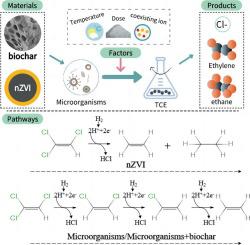Science of the Total Environment ( IF 8.2 ) Pub Date : 2023-03-15 , DOI: 10.1016/j.scitotenv.2023.162720 Jing Ma 1 , Manxi Xie 2 , Nan Zhao 2 , Yue Wang 2 , Qingqi Lin 1 , Yanping Zhu 1 , Yuanqing Chao 2 , Zhuobiao Ni 1 , Rongliang Qiu 3

|
Trichloroethylene (TCE) is one of the most prevalent contaminants with long-term persistence and a strong carcinogenic risk. Biological dechlorination has gradually become the mainstream method due to its advantages of low treatment cost and high environmental friendliness. However, microorganisms are easily restricted by environmental factors, such as an insufficient energy supply and a slow biological dechlorination process. This study focused on the coupled degradation of TCE with the combination of microorganisms and assistant materials (biochar, nZVI, nZVI modified biochar, HPO3 modified biochar), and set up microorganisms (alone) and materials (alone) as separate controls. Biochar provided nutrients, increased contact with pollutants, and promoted electron transfer to improve TCE degradation, although it did not change the pathway of degradation. The coupled treatment with anaerobic microorganisms (Micro) and 1 g/L unmodified biochar (BC) had the strongest degradation capacity. Compared with microorganisms alone, the addition of biochar resulted in the complete removal of TCE within 4 days. The influence of ambient temperature was mainly related to microbial activity, and 35 °C showed better degradation than 20 °C. Under 20 °C, 1 g/L of nZVI significantly promoted microbial dechlorination. As the dosage increased to 2 g/L and 4 g/L, nZVI showed a strong toxic effect. After 16 days, TCE was completely converted to ethylene by Micro-BC with C3H5O3Na, while 4.40 μmol dichloroethane (DCE) and 1.48 μmol vinyl chloride (VC) remained in the treatment with Micro-BC alone. As an electron acceptor, NaNO3 directly competed with TCE in the reduction process, which decreased the reduction efficiency of TCE. These findings provide a better understanding of the mechanism of the chemical materials coupling microbial dechlorination process and an optimal treatment method for trichloroethylene degradation.
中文翻译:

增强三氯乙烯生物降解:微生物与碳-铁材料结合的机理及影响因素
三氯乙烯 (TCE) 是最普遍的污染物之一,具有长期持久性和强烈的致癌风险。生物脱氯以其处理成本低、环境友好性高等优点逐渐成为主流方法。然而,微生物容易受到环境因素的限制,例如能量供应不足和生物脱氯过程缓慢。本研究重点研究了微生物与辅助材料(生物炭、nZVI、nZVI 改性生物炭、HPO 3改性生物炭),并将微生物(单独)和材料(单独)设置为单独的控件。生物炭提供养分,增加与污染物的接触,并促进电子转移以改善TCE降解,尽管它没有改变降解途径。厌氧微生物(Micro)和1 g/L未改性生物炭(BC)的耦合处理具有最强的降解能力。与单独使用微生物相比,添加生物炭可在 4 天内完全去除 TCE。环境温度的影响主要与微生物活性有关,35℃比20℃降解效果好。在 20 °C 下,1 g/L 的 nZVI 显着促进微生物脱氯。随着剂量增加到 2 g/L 和 4 g/L,nZVI 表现出强烈的毒性作用。16天后,3 H 5 O 3 Na,而 4.40 μmol 二氯乙烷 (DCE) 和 1.48 μmol 氯乙烯 (VC) 保留在单独使用 Micro-BC 的处理中。NaNO 3作为电子受体在还原过程中直接与TCE竞争,降低了TCE的还原效率。这些发现有助于更好地理解化学材料耦合微生物脱氯过程的机理和三氯乙烯降解的最佳处理方法。











































 京公网安备 11010802027423号
京公网安备 11010802027423号